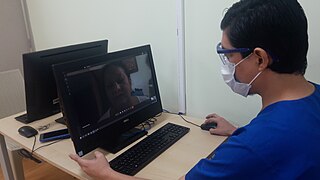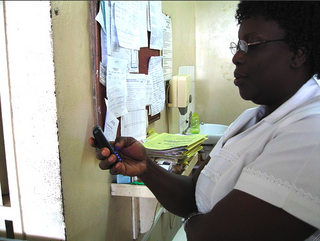Related Research Articles

Cognitive behavioral therapy (CBT) is a psycho-social intervention that aims to reduce symptoms of various mental health conditions, primarily depression and anxiety disorders. Cognitive behavioral therapy is one of the most effective means of treatment for substance abuse and co-occurring mental health disorders. CBT focuses on challenging and changing cognitive distortions and their associated behaviors to improve emotional regulation and develop personal coping strategies that target solving current problems. Though it was originally designed to treat depression, its uses have been expanded to include many issues and the treatment of many mental health conditions, including anxiety, substance use disorders, marital problems, ADHD, and eating disorders. CBT includes a number of cognitive or behavioral psychotherapies that treat defined psychopathologies using evidence-based techniques and strategies.
Psychotherapy is the use of psychological methods, particularly when based on regular personal interaction, to help a person change behavior, increase happiness, and overcome problems. Psychotherapy aims to improve an individual's well-being and mental health, to resolve or mitigate troublesome behaviors, beliefs, compulsions, thoughts, or emotions, and to improve relationships and social skills. Numerous types of psychotherapy have been designed either for individual adults, families, or children and adolescents. Certain types of psychotherapy are considered evidence-based for treating some diagnosed mental disorders; other types have been criticized as pseudoscience.
Group psychotherapy or group therapy is a form of psychotherapy in which one or more therapists treat a small group of clients together as a group. The term can legitimately refer to any form of psychotherapy when delivered in a group format, including art therapy, cognitive behavioral therapy or interpersonal therapy, but it is usually applied to psychodynamic group therapy where the group context and group process is explicitly utilized as a mechanism of change by developing, exploring and examining interpersonal relationships within the group.

Telehealth is the distribution of health-related services and information via electronic information and telecommunication technologies. It allows long-distance patient and clinician contact, care, advice, reminders, education, intervention, monitoring, and remote admissions. Telemedicine is sometimes used as a synonym, or is used in a more limited sense to describe remote clinical services, such as diagnosis and monitoring. When rural settings, lack of transport, a lack of mobility, conditions due to outbreaks, epidemics or pandemics, decreased funding, or a lack of staff restrict access to care, telehealth may bridge the gap as well as provide distance-learning; meetings, supervision, and presentations between practitioners; online information and health data management and healthcare system integration. Telehealth could include two clinicians discussing a case over video conference; a robotic surgery occurring through remote access; physical therapy done via digital monitoring instruments, live feed and application combinations; tests being forwarded between facilities for interpretation by a higher specialist; home monitoring through continuous sending of patient health data; client to practitioner online conference; or even videophone interpretation during a consult.
eHealth describes healthcare services which are supported by digital processes, communication or technology such as electronic prescribing, Telehealth, or Electronic Health Records (EHRs). The use of electronic processes in healthcare dated back to at least the 1990s. Usage of the term varies as it covers not just "Internet medicine" as it was conceived during that time, but also "virtually everything related to computers and medicine". A study in 2005 found 51 unique definitions. Some argue that it is interchangeable with health informatics with a broad definition covering electronic/digital processes in health while others use it in the narrower sense of healthcare practice using the Internet. It can also include health applications and links on mobile phones, referred to as mHealth or m-Health. Key components of eHealth include electronic health records (EHRs), telemedicine, health information exchange, mobile health applications, wearable devices, and online health information. These technologies enable healthcare providers, patients, and other stakeholders to access, manage, and exchange health information more effectively, leading to improved communication, decision-making, and overall healthcare outcomes.

Telerehabilitation (or e-rehabilitation is the delivery of rehabilitation services over telecommunication networks and the internet. Telerehabilitation allows patients to interact with providers remotely and can be used both to assess patients and to deliver therapy. Fields of medicine that utilize telerehabilitation include: physical therapy, occupational therapy, speech-language pathology, audiology, and psychology. Therapy sessions can be individual or community-based. Types of therapy available include motor training exercises, speech therapy, virtual reality, robotic therapy, goal setting, and group exercise.

Telepsychiatry or telemental health refers to the use of telecommunications technology to deliver psychiatric care remotely for people with mental health conditions. It is a branch of telemedicine.

mHealth is an abbreviation for mobile health, a term used for the practice of medicine and public health supported by mobile devices. The term is most commonly used in reference to using mobile communication devices, such as mobile phones, tablet computers and personal digital assistants (PDAs), and wearable devices such as smart watches, for health services, information, and data collection. The mHealth field has emerged as a sub-segment of eHealth, the use of information and communication technology (ICT), such as computers, mobile phones, communications satellite, patient monitors, etc., for health services and information. mHealth applications include the use of mobile devices in collecting community and clinical health data, delivery/sharing of healthcare information for practitioners, researchers and patients, real-time monitoring of patient vital signs, the direct provision of care as well as training and collaboration of health workers.
Cognitive behavioral therapy for insomnia (CBT-I) is a technique for treating insomnia without medications. Insomnia is a common problem involving trouble falling asleep, staying asleep, or getting quality sleep. CBT-I aims to improve sleep habits and behaviors by identifying and changing the thoughts and the behaviors that affect the ability of a person to sleep or sleep well.
PTSD or post-traumatic stress disorder, is a psychiatric disorder characterised by intrusive thoughts and memories, dreams or flashbacks of the event; avoidance of people, places and activities that remind the individual of the event; ongoing negative beliefs about oneself or the world, mood changes and persistent feelings of anger, guilt or fear; alterations in arousal such as increased irritability, angry outbursts, being hypervigilant, or having difficulty with concentration and sleep.
In psychology, relationship obsessive–compulsive disorder (ROCD) is a form of obsessive–compulsive disorder focusing on close or intimate relationships. Such obsessions can become extremely distressing and debilitating, having negative impacts on relationships functioning.

An activity tracker involves the practice of measuring and collecting data on an individual's physical and psychological activity to keep track and maintain documentation regarding their health and wellness. Used for many groups even animals as seen in collar-mounted activity trackers for dogs. A lot of the data is collected through wearable technology such as wristbands which sync with mobile apps through Apple and Samsung. As daily technologies such as phones and computers have been innovated, it paved the way for such wearable tracking technologies to be advanced. There are a variety of stakeholders involved in the usage of activity tracking through wearable technology and mobile health apps, knowing how much they track ranging from fitness, mood, sleep, water intake, medicine usage, sexual activity, menstruation, and potential diseases raises the concern on privacy given a lot of data is collected and analyzed. Through many studies that have been reviewed, data on the various demographics and goals these technologies are used provide more insight into their purposes.
Trauma focused cognitive behavioral therapy (TF-CBT) is an evidence-based psychotherapy or counselling that aims at addressing the needs of children and adolescents with post traumatic stress disorder (PTSD) and other difficulties related to traumatic life events. This treatment was developed and proposed by Drs. Anthony Mannarino, Judith Cohen, and Esther Deblinger in 2006. The goal of TF-CBT is to provide psychoeducation to both the child and non-offending caregivers, then help them identify, cope, and re-regulate maladaptive emotions, thoughts, and behaviors. Research has shown TF-CBT to be effective in treating childhood PTSD and with children who have experienced or witnessed traumatic events, including but not limited to physical or sexual victimization, child maltreatment, domestic violence, community violence, accidents, natural disasters, and war. More recently, TF-CBT has been applied to and found effective in treating complex posttraumatic stress disorder.
Mindfulness and technology is a movement in research and design, that encourages the user to become aware of the present moment, rather than losing oneself in a technological device. This field encompasses multidisciplinary participation between design, psychology, computer science, and religion. Mindfulness stems from Buddhist meditation practices and refers to the awareness that arises through paying attention on purpose in the present moment, and in a non-judgmental mindset. In the field of Human-Computer Interaction, research is being done on Techno-spirituality — the study of how technology can facilitate feelings of awe, wonder, transcendence, and mindfulness and on Slow design, which facilitates self-reflection. The excessive use of personal devices, such as smartphones and laptops, can lead to the deterioration of mental and physical health. This area focuses on redesigning and creating technology to improve the wellbeing of its users.
Christopher James Alfred Granville Fairburn is a British psychiatrist and researcher. He is Emeritus Professor of Psychiatry at the University of Oxford. He is known for his research on the development, evaluation and dissemination of psychological treatments, especially for eating disorders.
Digital therapeutics, a subset of digital health, are evidence-based therapeutic interventions driven by high quality software programs to prevent, manage, or treat a medical disorder or disease. Digital therapeutic companies should publish trial results inclusive of clinically meaningful outcomes in peer-reviewed journals. The treatment relies on behavioral and lifestyle changes usually spurred by a collection of digital impetuses. Because of the digital nature of the methodology, data can be collected and analyzed as both a progress report and a preventative measure. Treatments are being developed for the prevention and management of a wide variety of diseases and conditions, including type 1 & type II diabetes, congestive heart failure, obesity, Alzheimer's disease, dementia, asthma, substance abuse, ADHD, hypertension, anxiety, depression, and several others. Digital therapeutics often employ strategies rooted in cognitive behavioral therapy.
Mental health informatics is a branch of health or clinical informatics focused on the use of information technology (IT) and information to improve mental health. Like health informatics, mental health informatics is a multidisciplinary field that promotes care delivery, research and education as well as the technology and methodologies required to implement it.

Behavioral sleep medicine (BSM) is a field within sleep medicine that encompasses scientific inquiry and clinical treatment of sleep-related disorders, with a focus on the psychological, physiological, behavioral, cognitive, social, and cultural factors that affect sleep, as well as the impact of sleep on those factors. The clinical practice of BSM is an evidence-based behavioral health discipline that uses primarily non-pharmacological treatments. BSM interventions are typically problem-focused and oriented towards specific sleep complaints, but can be integrated with other medical or mental health treatments. The primary techniques used in BSM interventions involve education and systematic changes to the behaviors, thoughts, and environmental factors that initiate and maintain sleep-related difficulties.

Internet-based treatments for trauma survivors is a growing class of online treatments that allow for an individual who has experienced trauma to seek and receive treatment without needing to attend psychotherapy in person. The progressive movement to online resources and the need for more accessible mental health services has given rise to the creation of online-based interventions aimed to help those who have experienced traumatic events. Cognitive behavioral therapy (CBT) has shown to be particularly effective in the treatment of trauma-related disorders and adapting CBT to an online format has been shown to be as effective as in-person CBT in the treatment of trauma. Due to its positive outcomes, CBT-based internet treatment options for trauma survivors has been an expanding field in both research and clinical settings.

Alison Darcy is a research psychologist and technologist. She is the Founder and President of Woebot Health, a company which provides digital therapeutics and behavioural health products.
References
- ↑ Wechsler LR, Tsao JW, Levine SR, Swain-Eng RJ, Adams RJ, Demaerschalk BM, et al. (American Academy of Neurology Telemedicine Work Group) (February 2013). "Teleneurology applications: Report of the Telemedicine Work Group of the American Academy of Neurology". Neurology. 80 (7): 670–676. doi:10.1212/WNL.0b013e3182823361. PMC 3590056 . PMID 23400317.
- ↑ Della Mea V (22 June 2001). "What is e-health (2): the death of telemedicine?". Journal of Medical Internet Research. 3 (2): E22. doi: 10.2196/jmir.3.2.e22 . PMC 1761900 . PMID 11720964.
- ↑ Kummervold PE, Johnsen JA, Skrøvseth SO, Wynn R (September 2012). "Using noninferiority tests to evaluate telemedicine and e-health services: systematic review". Journal of Medical Internet Research. 14 (5): e132. doi: 10.2196/jmir.2169 . PMC 3510769 . PMID 23022989.
- ↑ Nicolas L (September 2012). "[EHealth, health networks and electronic health record: towards a culture of sharing and trust]" [EHealth, health networks and electronic health record: Towards a culture of sharing and trust]. Revue Médicale de Bruxelles (in French). 33 (4): 416–419. PMID 23091950.
- 1 2 Marcano-Belisario JS, Gupta AK, O'Donoghue J, Morrison C, Car J (January 2016). "Tablet computers for implementing NICE antenatal mental health guidelines: protocol of a feasibility study". BMJ Open. 6 (1): e009930. doi:10.1136/bmjopen-2015-009930. PMC 4735209 . PMID 26801468.
- ↑ Doherty G, Coyle D, Matthews M (July 2010). "Design and evaluation guidelines for mental health technologies". Interacting with Computers. 22 (4): 243–252. doi:10.1016/j.intcom.2010.02.006. S2CID 10486226.
- ↑ Anthony K, Nagel DA, Goss S, eds. (2010). The Use of Technology in Mental Health: Applications, Ethics and Practice. Springfield, IL: Charles C. Thomas Publishers. ISBN 978-0-398-07953-6 – via Google Books.
- ↑ "Game Directory". Games For Change.
- ↑ "SuperBetter". Apple App Store. 12 June 2023.
- ↑ "SuperBetter". Google Play App Store.
- ↑ Rizzo A, Pair J, Graap K, Manson B, McNerney PJ, Wiederhold B, et al. (2006). "A Virtual Reality Exposure Therapy Application for Iraq War Military Personnel with Post Traumatic Stress Disorder: From Training to Toy to Treatment" (PDF). In Roy M (ed.). NATO Advanced Research Workshop on Novel Approaches to the Diagnosis and Treatment of Posttraumatic Stress Disorder. Washington, DC: IOS Press. pp. 235–250.
- ↑ Coyle D, Matthews M, Sharry J, Nisbet A, Doherty G (2005). "Personal Investigator: A Therapeutic 3D Game for Adolescent Psychotherapy". Journal of Interactive Technology & Smart Education. 2 (2): 73–88. CiteSeerX 10.1.1.101.9049 . doi:10.1108/17415650580000034. S2CID 18405937.
- ↑ Merry SN, Stasiak K, Shepherd M, Frampton C, Fleming T, Lucassen MF (April 2012). "The effectiveness of SPARX, a computerised self help intervention for adolescents seeking help for depression: randomised controlled non-inferiority trial". BMJ. 344: e2598. doi:10.1136/bmj.e2598. PMC 3330131 . PMID 22517917.
- ↑ Goss S, Ferns J (2010). "Using Cell/Mobile Phone SMS to Enhance Client Crisis and Peer Support". In Anthony K, Nagel DA, Goss S (eds.). The Use of Technology in Mental Health: Applications, Ethics and Practice. Springfield, IL: Charles C. Thomas Pub Ltd. pp. 56–67. ISBN 978-0-398-07953-6 – via Google Books.
- ↑ Morris ME (February 15, 2007). "Technologies for Heart and Mind: New Directions in Embedded Assessment". Intel Technology Journal. 11 (1). doi:10.1535/itj.1101.07. Archived from the original on 2008-08-18.
- ↑ Quan-Haase A (2015). Technology and Society: Social Networks, Power, and Inequality. Themes in Canadian Sociology (Second ed.). Don Mills, Ontario, Canada: Oxford University Press. pp. 222–223. ISBN 978-0-19-901471-2.
- ↑ "How Chatbots and AI are Changing the Healthcare Industry". 11 July 2022.
- ↑ Inkster B, Sarda S, Subramanian V (November 2018). "An Empathy-Driven, Conversational Artificial Intelligence Agent (Wysa) for Digital Mental Well-Being: Real-World Data Evaluation Mixed-Methods Study". JMIR mHealth and uHealth. 6 (11): e12106. doi: 10.2196/12106 . PMC 6286427 . PMID 30470676.
- ↑ Thomas N, Woodyatt A (16 June 2020). "Children with ADHD can now be prescribed a video game, FDA says". CNN. Retrieved 18 June 2020.
- ↑ Rathbone AL, Clarry L, Prescott J (November 2017). "Assessing the Efficacy of Mobile Health Apps Using the Basic Principles of Cognitive Behavioral Therapy: Systematic Review". Journal of Medical Internet Research. 19 (11): e399. doi: 10.2196/jmir.8598 . PMC 5727354 . PMID 29187342.
- 1 2 McAlpine DD, McCreedy E, Alang S (June 2018). "The Meaning and Predictive Value of Self-rated Mental Health among Persons with a Mental Health Problem". Journal of Health and Social Behavior. 59 (2): 200–214. doi:10.1177/0022146518755485. PMID 29406825. S2CID 46799083.
- ↑ Bell S, Wood C, Sarkar A (2019). "Perceptions of Chatbots in Therapy". Extended Abstracts of the 2019 CHI Conference on Human Factors in Computing Systems. ACM. pp. LBW1712:1–LBW1712:6. doi:10.1145/3290607.3313072. ISBN 9781450359719. S2CID 144207472 . Retrieved 22 August 2019.
- ↑ "Mobile app combined with face-to-face therapy helped people with psychosis". NIHR Evidence (Plain English summary). National Institute for Health and Care Research. 2022-05-19. doi:10.3310/nihrevidence_50569. S2CID 249945572.
- ↑ Garety P, Ward T, Emsley R, Greenwood K, Freeman D, Fowler D, et al. (August 2021). "Digitally supported CBT to reduce paranoia and improve reasoning for people with schizophrenia-spectrum psychosis: the SlowMo RCT". Efficacy and Mechanism Evaluation. 8 (11): 1–90. doi: 10.3310/eme08110 . PMID 34398537. S2CID 238644547.
- ↑ Gega L, Jankovic D, Saramago P, Marshall D, Dawson S, Brabyn S, et al. (January 2022). "Digital interventions in mental health: evidence syntheses and economic modelling". Health Technology Assessment. 26 (1). National Institute for Health and Care Research (NIHR): 1–182. doi:10.3310/RCTI6942. PMC 8958412 . PMID 35048909.
- 1 2 Gooding P, Kariotis T (June 2021). "Ethics and Law in Research on Algorithmic and Data-Driven Technology in Mental Health Care: Scoping Review". JMIR Mental Health. 8 (6): e24668. doi: 10.2196/24668 . PMC 8262551 . PMID 34110297.